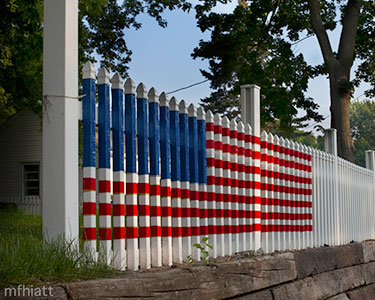For which it stands

Flag fence. Photo: Mike Hiatt, Creative Commons, some rights reserved
Today is Flag Day, commemorating the adoption of the flag of the United States by the Second Continental Congress on June 14, 1777. While not a federal work holiday, it has been commemorated with parades, flag displays, fireworks and other patriotic observances for more than a century.
While I number myself among the “small p” patriots, I have never been much given to flag-waving in the political sense, much as I am a church-goer without being any great guns as an evangelist.
Over its history, our flag has become a potent symbol, and over time it has been used in ways that unify us as a nation, and in ways that divide us. Everyone seems to squabble over who or what is the true America.
So, who owns the flag? Is it the star-spangled banner of battlements, or the ornament of the civic square? Or something else altogether? America, I think, has spawned more different kinds of patriots than there are stars on the blue field.
I remember the furor after the Woodstock Festival, where Jimi Hendrix wailed out a soaring, bent and exuberant version of the “Star Spangled Banner” on solo electric guitar. While many people saw it as an affront, to me it seemed a quintessential American expression of freedom in its wildest state–an enormous, brawling, individualistic, rough-edged anthem with “Don’t Tread on Me” blaring in every note.
Another strain of patriotism is embodied in the lovingly subversive lyrics of “This Land is Your Land” or “Buddy, Can You Spare a Dime.” Still another in identification with the land itself embodied by John Muir, or in the egalitarian vision and sacrifice of Martin Luther King.
While much blood has been expended in its service, the flag is bigger than the battlefields over which it has flown. America, too, is bigger than our differences, and its flag enfolds more than just our politics.
Tags: listeningpost








So well-stated, Dale. Thank you.
Odd, the first time I heard Hendrix’s Star-Spangled Banner it struck me as a statement of the contrasting images of a free country built on the back of slavery, Jim Crow, segregated schools and housing.
Hi Jon–
I don’t disagree. But what I heard is also in there. The complexity and mating of contradictions is what keeps that performance in my mind all these years later.
Dale
Another image of the flag is the one sent home from the coffin of a soldier buried overseas in the days before final flights home. They don’t have the same number of stars as the ones flown today, but they are cherished by the families that received them.
All you have to do is look at the costuming of some of the World Cup Soccer Games currently going on to see creative uses of flags, including ours.